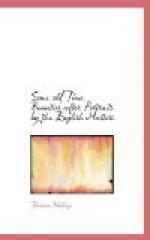Houston engraved a portrait of Maria after a drawing by J. St. Liotard. This is a three-quarter length figure. Her hair is in large plaits twined with a muslin veil on her head. The dress is open at the throat, showing a necklace. There is a wide belt with large clasps. Her left elbow rests on her knee. Perhaps the most satisfactory pictures of the Beauties are those by Catharine Read, who died, in 1786; and who is chiefly known by her winsome delineations of the graces of the Gunning girls. We could readily judge from these that the girls were attractive. There is a genial graciousness in the face of she of Coventry, while the Scotch duchess is possessed of a persuasive sweetness of mien. The mob-cap frames a face almost faultless in the regularity of its features. For all the pleasant flavor of these facial charms, there is absent that peerless, regal loveliness, that compelling magnificence of presence, that hauteur which dazzles and enthrals.
The originals of these various portraits have been retained at Croome Court, near Worcester; the seat of the Coventry family, at Inverary Castle, Argyllshire; and at Hamilton Palace.
Three weeks after the romantic marriage of her younger sister, Maria Gunning was married to George William, who was Lord Deerhurst—“that grave young Lord,” Walpole calls him—until 1750, when he succeeded to the Earldom of Coventry. He had been dangling about her for some time, and seemed nerved to the wedding by his Grace of Hamilton’s precipitate action. The Earl took her for a trip on the Continent in company with Lady Caroline Petersham, that other great beauty. Neither caused much comment abroad, and Paris did not ratify the repute of London. My Lady was at a disadvantage from her ignorance of the French language. She complained, too, of the arbitrary rule of her husband in not allowing her red nor powder, so much in vogue with the Parisian beauties. It is told how he saw her appear at a dinner with some on, and took out his handkerchief, and there tried to rub it off. But her fame abated not in England. Crowds continued to mob her whenever she appeared on the street. The King was pleased to order that whenever my Lady Coventry walked abroad she should be attended by a guard of soldiers. Shortly after this she simulated great fright at the curiosity of the mob, and asked for escort. She then paraded in the park, accompanied by her husband and Lord Pembroke, preceded by two sergeants, and followed by twelve soldiers. Surely this outdoes the advertising genius of any latter-day American actress! A shoemaker at Worcester gained two guineas and a half by exhibiting at a penny a head a shoe he had made for the Countess. She was in much favor at Court, and always circulated in an atmosphere of adulation and sensation. The Duke of Cumberland was an admirer, as was also, more emphatically, Fred St. John, Viscount Bolingbroke,—“Billy and Bully” these two blades were termed.




